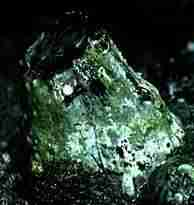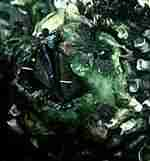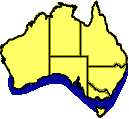|
|

Giant Rock Barnacle, Balanus nigrescens
Form:
 The
Giant Rock Barnacle Barnacle is a very large barnacle,
both tall and wide, with six distinct steep-sided marginal or side-plates,
marked with transverse lines.
The
Giant Rock Barnacle Barnacle is a very large barnacle,
both tall and wide, with six distinct steep-sided marginal or side-plates,
marked with transverse lines.
The shell plates are often eroded and encrusted with marine algae and organisms.
This is the largest of the Australian barnacles.
Colour:

The outside of the Giant Rock Barnacle shell plates are white to pale green in colour. Inside the operculum, the valves have a distinctive bright caerulean blue mantle, which is characteristic of the species.
Phylum: |
Arthropoda |
Author: |
Lamarck, 1818 |
Family: |
Balanidae |
Size: |
30-60 high; 25-30 mm diameter |
Distribution:
 The
Giant Rock Barnacle occurs from New South Wales , down to Victoria, ranging
into Western Australia. Although it is rare in Tasmanian waters, it is
common on the shores of Deal Island in Bass Strait.
The
Giant Rock Barnacle occurs from New South Wales , down to Victoria, ranging
into Western Australia. Although it is rare in Tasmanian waters, it is
common on the shores of Deal Island in Bass Strait.
Habitat:
The Giant Rock Barnacle is found low on the shore at and below low tide level on rocky shores where there is medium to strong wave action.
It commonly occurs on steep rock faces, pounded by the surf. It may occur singly or in groups.
References:
Bennett, I. (1987) W. J. Dakin's classic study: Australian Seashores. p.245, Angus & Robertson, Sydney.
Davey, K. (1998) A Photographic Guide to Seashore Life of Australia. p.44, New Holland, Sydney.
Marine Research Group of Victoria (1984) Coastal Invertebrates of Victoria: an atlas of selected species. p.108, Museum of Victoria, Melbourne.
Underwood, A. J. & Chapman, M. G. (1993) Seashores: a beachcomber's guide. p.36, New South Wales University Press, Sydney.
Surf
Barnacle
Six-plated Barnacle
Honeycomb Barnacle
Rose-coloured Barnacle
Rosette Barnacle
Giant Rock Barnacle
Home
Page
Taxonomy
Biogeography
Rocky Shores
Tidal Levels
Intertidal Zonation
Environmental Factors
Biological
Factors
Feeding Relationships
Activities
Glossary
References
 Life
on Australian Seashores
Life
on Australian Seashores
by Keith Davey (C) 2000
Learning Consultant
- Media
The University of Newcastle
email at australian_seashores@hotmail.com
Scientific Consultant: Phil
Colman
site created 01.01.98 : updated 01.04.2000